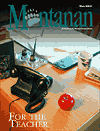
Winter 2001
CONTENTS
Managing the Mountain
Teachers Who Change Lives
AROUND THE OVAL
LETTERS TO THE EDITOR
UM FACES
SPORTS
CLASS NOTES
ALUMNI NOTES
Contact Us
About the Montanan
PAST ISSUES
Dear Montanan Editor
. . . I loved your Campus Clues article, but help please! I need a map.
Claudia Tidball
An e-mail to Rita Munzenrider Hello Rita,I read the interesting note on the disappearing trees on the Oval in the Fall Montanan and hope that some generous benefactor with an arboreal bent will foot the bill for some new trees. It is my understanding, however, that only the name of the disease is “Dutch elm.” The beautiful trees that fall victim to this disease are our native American elm trees. By the way, the Campus Clues section is quite fun — thanks for an up-close look at UM’s architectural highlights.
Poody McLaughlin
An e-mail to Bob Frazier
Bob: I think I told you this before, but I will say it again.That publication, the Montanan, is really something else. Of all the crap I get from universities, that’s one thing that always ends up on my night stand at home. The last issue was great. I even played the campus sleuth game or whatever it was called. Scored 0, but it was good reading.
Brian C. White
Dear Joan Melcher, Hello! I just read your article “Saving Virginia City” in the Montanan magazine. Thank you for your wonderful article! However, I was rather disappointed to find no mention of the preservation crew. The preservation crew has but one goal — to find a way to keep the buildings of Virginia City from falling down. The best way to accomplish this goal is to build a structure inside each building that will not only stabilize the building, but be structurally sound, aesthetically pleasing, able to withstand seismic events and, most importantly, be historically accurate. The crew has concentrated its efforts this year in Sauerbier Blacksmith Shop. Work has consisted of building a timber frame structure inside the building, which supports the entire building and will enable it to stand for another 150 years. In addition, the crew assists with many other projects, from boardwalk replacement to archaeology to compliance issues. Catherine Nemeth ’96, M.A. ’97
Dear Editor: I was very interested to read your article on Virginia City in the latest issue of the Montanan. I had been wondering what was happening to it since I saw a feature on it on CBS “Sunday Morning” several years ago. I grew up in Cascade and remember several trips there as a child. My father, Harlan Mattson, knew Charlie Bovey. I remember when he started collecting historic buildings and assembled them as Old Town in the fairgrounds in Great Falls. Then in 1969, my mother took my four children and me to Virginia City for several days and we loved it. I’m passing the article on to several of my children to let them know what has happened to Virginia City
Marilyn M. Dickinson ’54
Dear Editor: I was happy to see your article on Virginia City in the recent Montanan. It is indeed a significant project and one that all Montanans and UM alumni should support. I felt in mentioning the contributions of UM and its alumni that you overlooked some significant contributions.The Montana Historical Society Foundation took the initiative and negotiated a purchase option with Mr. Bovey’s lawyers. The foundation took a huge chance that the Legislature would ultimately make good on the option. It was before my retirement in 1998 as director of MHS and executive director of its foundation. Ward Shanahan was and is president of the foundation. Jeanette Sayer McKee was the fundraising officer. All three of us are proud alumni of UM. I should also note that the lobbyist that the foundation hired to help secure legislative agreement is I believe an alumni of the UM law school — Mona Jamison. Lastly, the faculty of UM’s history department raised several thousand dollars to go toward the purchase-option cost — the only institution of higher learning in Montana to show that support. Thank you for putting up with this and with providing a vehicle to keep up with events on campus.
Brian Cockhill
Dear Joan: Just a quick note to say well done and thank you for the article about Virginia City. Many have commented positively about it.
Jeff Tiberi
Dear Mr. Editor: The Montanan issue (Spring 2000), “Not Your Father’s Generation,” has been gnawing on my mind for months; it can only be purged by sending you my reaction. I try to understand this culture, but it is hard. Should any of today’s students want to understand my cultural background (improbable; call it research), I would suggest they go over to the library and check out The Sentinel for 1940. Look at the pictures: the men and women portrayed there — especially the latter. These were strong women. Most of them had grandparents who came west with a wagon train. All of them surmounted the depression. They had a common purpose at the University: to be the best educated wives and mothers in the state. The men accepted their obligations to take ROTC and marched proudly in the Grizzly Regiment. Nearly all of them were in the armed services within two years. I suspect academic standards were higher then, and students had less time and money for drinking or policing the environment. No matter how mean their estate, they all wore coats and ties (or occasionally, sweaters), pressed pants, and shined shoes; with hair cut, and clean shaven. I don’t know what is meant by “not your father’s generation” — sounds like a kind of in-your-face rejection of previous generational standards? Excuse my acerbity.
Hal Ekern ’41
AROUND THE OVAL• SPORTS • CLASS NOTES • ALUMNI NOTES FEEDBACK•STAFF • ABOUT THE MONTANAN •ARCHIVES HOME • CONTENTS
|